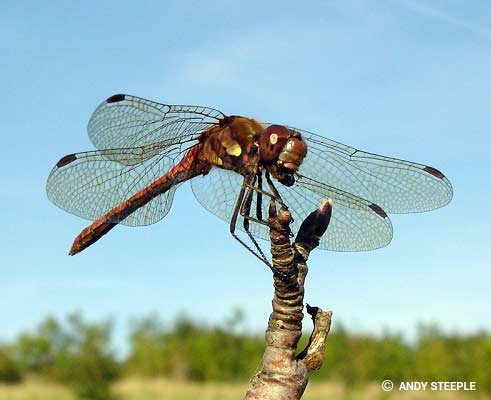by Ashley Beolens
Bright colourful and alien looking, dragonflies (and damselflies) are some of the most unusual creatures you or I are likely to come across, moving at seemingly impossible speeds and always seeming to be on the go, these insects can be a challenge to even the most experienced photographer, but there are ways to increase your chances of getting the wall perfect shot. Hopefully, here, you will gain a much better understanding of how you could achieve these shots yourself.
Equipment
Now while you won't need hugely expensive gear to get an OK shot of one of these flying monsters, if you follow my tips a point and shoot will get you something, however the best photographs will be achieved with decent kit.
With that said the better your kit the more it will allow you to get photos. An SLR will allow you more control but it will be your lens choice that will be most debated. There are two schools of thought. One (and this is what I currently use) is to use a good macro lens, and get in close to your subject, this requires patience and a fair bit of luck. The other choice is to use a much longer lens (300-500mm) but use extension tubes in order to reduce the minimum focal distance in order to allow you to get frame filling pictures. This second option allows you to keep at a distance and therefore you are less likely to spook the insect. (If you already have a long lens this can be a very cheap option, look for extension tubes on Amazon, they really are cost effective).
While using natural sunlight is preferred you may also find it useful to have a decent flash unit as well, this will help make sure you get decent fill light on your subject (a ring light is ideal for this in macro photography but any flash helps, and using an extender will work very well with longer lenses).
Understanding
Once you have your gear ready the first and most important step, and I can't emphasise this enough, you must learn the subject, on your first attempt at photographing dragonflies you are likely to fail if you have not spent time watching them first.
Most dragonflies (especially the bigger species) follow set feeding and flight routes, or have favourite perches or hover points. If you study them, and watch what they do and where they go you will be able to set yourself up in a position to photograph the dragonfly most often when at rest, but with this technique also while in flight (a very difficult job). This is why knowing your subject is vital.
Stealth
When photographing dragonflies it is, like with all wildlife photography, advisable to dress in drab colours. Insects (which dragonflies are remember) are sensitive to UV (Ultraviolet) and bright colours tend to reflect UV more.
The best defence for a dragonfly comes in their ability to detect movement, so in order to get close to a dragonfly it is vital to keep your movements slow and even, fast, juddery movement will put your prey subject to flight. Move carefully and have your camera ready (it is no good sneaking up on a resting dragonfly only to jerk your camera up at the last second, you will have wasted your time).
Composition
When composing a dragonfly or damselfly photograph you need to think of a few things prior to pressing the button; what is your photograph for? Are you looking to achieve a photograph for identification purposes (either for other people to use as an aide or to help you identify it later on) if so you need to make sure you are focusing on the salient points, again knowing your subject matter here will help you know how to compose.
If, on the other hand, you are looking at aesthetically pleasing photos for display purposes, you will likely want to change your composition approach. Trying to keep backgrounds uncluttered and keeping the subject on a level will make a much nicer picture. For damselflies this often means getting down in amongst their habitat (knee protectors of some kind can help), for the larger species you will likely be looking to photograph them on an isolated post.
Depth of field
When you are photographing small objects of any kind at a close distance you will want to decide on how much of your subject is in focus, with insects you will likely want as much as possible to be sharp, this will require you to use small apertures and create a great (large) depth of field, unfortunately this will often make for lower shutter speeds, so whilst stabilising your camera becomes important, (and unless you have great light and a really good hand holding technique it is advisable to use a tripod or other support here) you may find you have to compromise in order to get shutter speeds at a level that is acceptable for freezing the subject. This again may help dictate your composition the more perpendicular you are to the subject the less likelihood these is of finding out of focus areas.
Hopefully with time, patience and practice you will be able to take some amazing images of dragonflies that really show off their lace-like wings and unusual features. I would certainly love to hear if the tips here help you to achieve this.
Also known as the fatphotographer Director and major contributor to the global photographic web resource http://www.fatphotographer.net
Article Source: http://EzineArticles.com/?expert=Ashley_Beolens
Article Source: http://EzineArticles.com/7225476